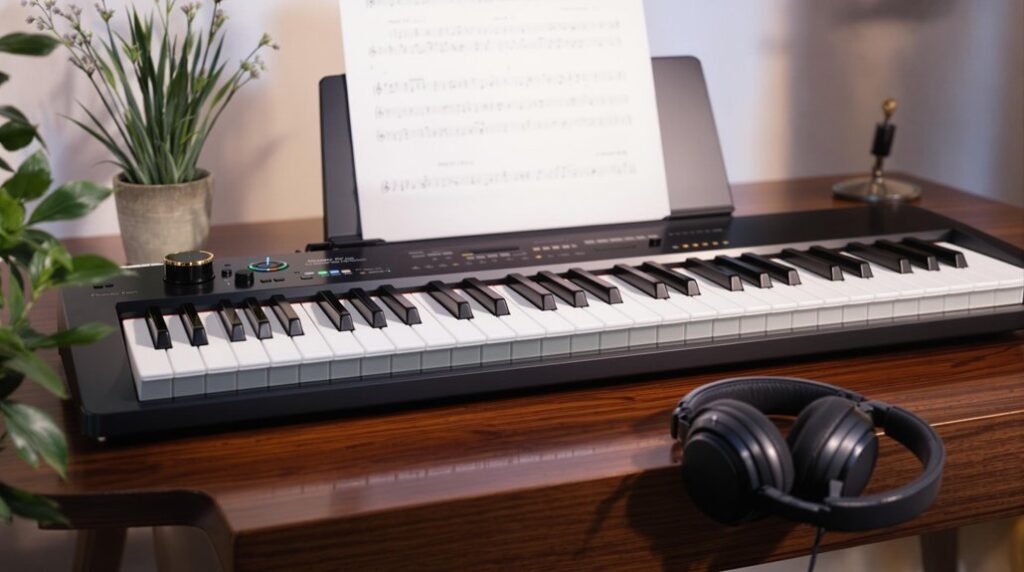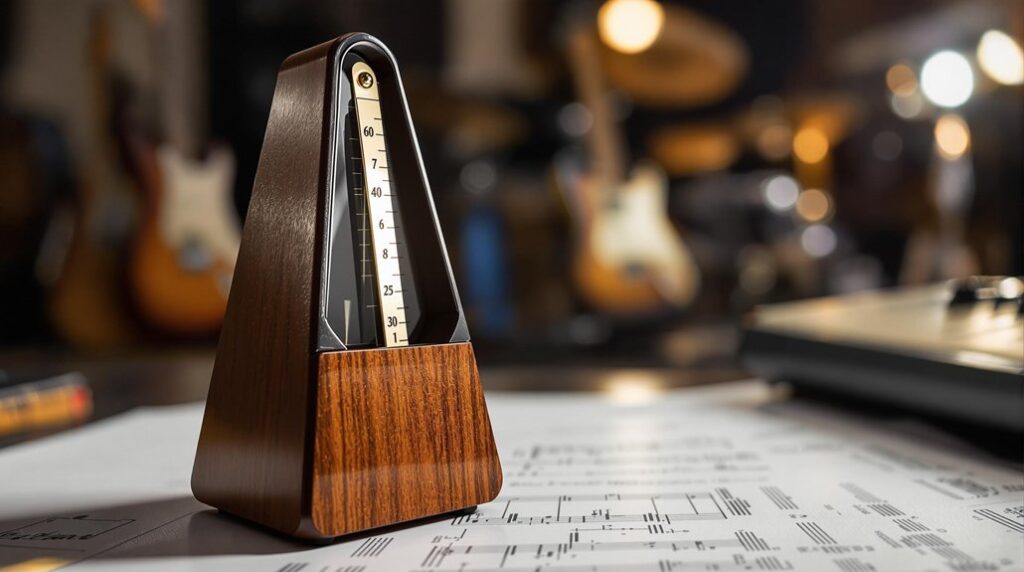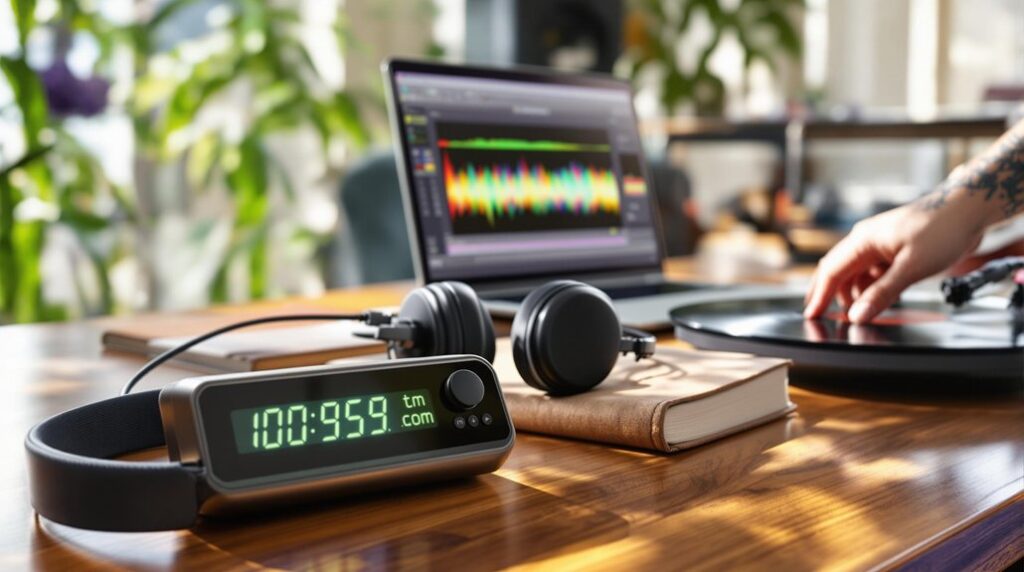Mastering advanced counterpoint to craft polyphonic masterpieces necessitates a thorough comprehension of multiple independent melodic lines that simultaneously create a rich harmonic structure. Originating in the Renaissance and peaking in complexity during the Baroque period with J.S. Bach, polyphony demands technical precision, combining rhythmic accuracy and melodic clarity. Analyzing scores to understand voice interplay, practicing hand division for coordination, and maintaining a strong rhythmic pulse are essential techniques. Additionally, historical performance practices and consistent interpretative skills are important for emotional expression and structural integrity. This foundational knowledge promises greater insights into the intricate art of polyphonic composition.
Key Takeaways
- Focus on developing melodic independence to ensure each line contributes distinctly to the polyphonic texture.
- Practice hand division techniques to improve coordination and clarity between independent melodic lines.
- Analyze scores away from the instrument to understand interactions, key changes, and thematic developments.
- Utilize rhythmic accuracy and beat subdivision to manage complex, multi-layered rhythms effectively.
- Engage with historical performance practices and composers’ intentions to enhance interpretative choices and emotional expression.
Understanding Polyphony
Delving into the intricate world of polyphony reveals a rich tapestry of interwoven melodic lines, each maintaining its independence while contributing to a cohesive harmonic structure. This compositional technique, fundamental in music for over six centuries, stands in contrast to homophonic styles, which prioritize a singular melody accompanied by chords.
Polyphony’s essence lies in its melodic independence, where each line is crafted to fulfill its own thematic and rhythmic roles. The relationship between strong and weak beats is vital in polyphonic music, as it helps to distinguish the independent melodic lines.
The Baroque period, particularly between 1600-1750, marked a pinnacle in polyphonic complexity, with J.S. Bach epitomizing the era’s advancements through his intricate fugues and preludes. Instruments such as the harpsichord, organ, and clavichord were integral to this period’s soundscape, with the clavichord favored by Bach for its expressive tonal qualities.
Analyzing polyphonic compositions necessitates a detailed approach, identifying each melodic strand, key changes, and thematic developments to unravel the work’s complexity. A profound understanding of harmonic interplay is essential, as it enables the interpreter to appreciate how independent lines merge to form a cohesive whole.
Mastery of polyphony also demands technical precision, particularly separate hand practice, to guarantee rhythmic accuracy and melodic clarity.
Historical Context
The evolution of polyphony is deeply entwined with the historical and cultural transformations of the Renaissance and Baroque periods. The Renaissance origins of counterpoint saw the emergence of multiple independent melodic lines, culminating in the richly textured compositions of Palestrina. This era laid the groundwork for a modal system that prioritized consonance and harmonic balance, integral to the development of counterpoint.
Understanding the fundamental elements of music theory, such as harmony and melody, is essential to grasping these early compositions.
With the Baroque evolution, counterpoint reached new heights, characterized by increased complexity and expressive depth. The shift from modal to diatonic systems facilitated the exploration of key changes and more intricate harmonic progressions. The works of J.S. Bach epitomize this Baroque evolution, showcasing the pinnacle of contrapuntal technique.
His fugues and chorales exemplify the intricate interplay of voices, driven by precise rhythmic notation that became more sophisticated during this period.
Johann Fux’s “Gradus ad Parnassum,” published in the 18th century, codified the principles of species counterpoint, providing a methodological framework that influenced subsequent generations of composers.
The Baroque period also witnessed a proliferation of counterpoint in sacred music, with composers leveraging its structural intricacy to enhance liturgical expressions. These historical developments underscore the profound impact of the Renaissance and Baroque periods on the art of counterpoint.
Analyzing Scores
A rigorous approach to score analysis is essential to mastering polyphonic compositions, offering invaluable insights into the intricate interplay of independent melodic lines. To begin, analyze the score away from the piano, concentrating on the shape and construction of each melodic line. This practice illuminates the nature of their interactions and relationships, a cornerstone of understanding polyphony.
Identifying key changes, cadential points, and thematic developments is vital. These elements provide a framework for comprehending the overall structure of the piece. Mark subject entries clearly in the score, using separate staves to visualize each musical line, which aids in articulation and interpretation. Annotating the score with fingerings and performance notes further personalizes and deepens your engagement with the work.
Employing a systematic approach to score analysis involves scrutinizing rhythmic patterns, harmonies, and contrapuntal techniques. This meticulous examination enhances your grasp of polyphonic writing and its complexities.
| Aspect | Focus Area | Purpose |
|---|---|---|
| Melodic Interaction | Shape and Construction | Understand Relationships |
| Thematic Development | Key Changes, Cadences | Structural Insight |
| Analytical Techniques | Rhythmic Patterns, Harmonies | Deepen Comprehension |
Such an analytical, technical approach to score analysis not only refines your interpretative skills but also enriches your understanding of polyphonic masterpieces.
Hand Division Practice
Building on the rigorous score analysis, hand division practice becomes a logical next step in mastering polyphonic compositions. Vital to this practice is the determination of which voices can be allocated to either hand, optimizing convenience and fluidity. This approach not only aids in hand coordination but also enhances voice balancing, ensuring each melodic line is distinctly articulated.
Separating the melodic lines during practice is essential for developing hand independence, a fundamental skill for maintaining clarity within the polyphonic texture. Slow practice techniques are invaluable; they allow for meticulous attention to each hand’s part, fostering a more precise and confident performance.
By isolating difficult passages and practicing them with a single hand, musicians can reinforce specific fingerings and articulations, ultimately facilitating smoother integration when both hands are played together.
Visual aids, such as separate staves for each hand, can be particularly effective. They help in clearly identifying and organizing the distinct musical lines, thereby providing a structured approach to practice.
This methodical division and focused practice not only enhance technical proficiency but also contribute to a more nuanced and balanced polyphonic rendition, underscoring the sophistication of the compositional craft.
Rhythm and Counting
In the domain of polyphonic music, a robust awareness of rhythm and precise counting is indispensable for achieving a coherent and compelling performance. The foundation of rhythmic reliability lies in maintaining a firm inner pulse, which guarantees clarity and effectiveness in contrapuntal textures. This is particularly essential in complex structures such as fugues and intricate dance movements.
To achieve a clearer, polished sound, consider incorporating techniques like subtractive EQ, which can help refine the mix by cutting unwanted frequencies.
To enhance rhythmic precision, consider the following strategies:
- Subdivide Beats: Regularly subdividing beats aids in steering the multi-layered rhythms of polyphonic music. This technique guarantees each note is placed accurately within the temporal framework, fostering a stable inner pulse.
- Count Every Note: Instead of relying solely on the beat, musicians should count each note. This method greatly improves rhythmic reliability, particularly when managing intricate rhythms and syncopations common in advanced counterpoint.
- Utilize a Metronome: While practicing with a metronome can establish a consistent tempo, the ultimate goal is to internalize this timing. Counting and maintaining an inner pulse mentally during performance is essential for rhythmic stability.
Developing these rhythmic skills not only enhances the execution of polyphonic works but also strengthens the overall musicianship required for interpretative excellence.
Interpretative Skills
In mastering the interpretative skills necessary for polyphonic compositions, musicians must focus on achieving nuance by understanding and articulating each individual melodic line with precision. This involves employing techniques for emotional expression and dynamic contrast, which are essential for highlighting the interplay and distinctiveness of each voice.
Nuance in Polyphonic Interpretation
Mastery in polyphonic interpretation hinges on an intricate comprehension of each individual melodic line and their collective interplay within the texture. Achieving this level of nuance necessitates a meticulous approach to voice blending and melodic clarity.
Musicians must guarantee that the primary melodic material is articulated clearly while maintaining the accompanying lines in a subordinate role. This balance allows listeners to distinguish between voices, preserving the integrity of the polyphonic structure.
To deepen interpretative skills, consider the following strategies:
- Score Analysis and Marking: Diligently analyze the score and mark it to highlight the primary and secondary roles of each line. This practice aids in maintaining the intended hierarchy and interaction of voices.
- Dynamic and Phrasing Variations: Experiment with different dynamics, phrasing, and tempo variations. These elements enhance the emotional depth and character of each part, contributing to a more nuanced performance.
- Voice Practice Techniques: Regularly practice singing one voice while playing others. This exercise reinforces the understanding of inter-line relationships and improves overall interpretative skills.
Engaging with historical performance practices and considering the composer’s intentions can further guide musicians in making informed, stylistically accurate interpretative choices.
Emotional Expression Techniques
Understanding the nuances of polyphonic interpretation naturally leads to exploring emotional expression techniques, an area where interpretative skills play a vital role. Mastering expressive phrasing is essential for conveying the emotional essence embedded within each melodic line. By focusing on the melodic nuances of individual voices, performers can articulate distinct feelings, ensuring that each line communicates its intended emotional character.
Incorporating dynamic contrasts and subtle tempo variations further enhances the emotive power of polyphonic music. However, these elements should be applied judiciously to maintain the integrity of the contrapuntal texture. Singling out individual voices during practice fosters a deeper connection to each line’s unique character. This approach allows musicians to deliver more expressive interpretations, as they can emphasize the emotional contours of each voice.
Historical context greatly influences interpretative skills. Understanding the composer’s intentions and the stylistic conventions of the period can guide performers in achieving an authentic emotional delivery.
Additionally, engaging with the harmonic and contrapuntal relationships between voices is vital. Recognizing moments of tension and resolution within the polyphonic fabric enables performers to convey emotional depth, enriching the listener’s experience. Consequently, emotional expression in counterpoint is a sophisticated interplay of technical precision and interpretative insight.
Dynamic Contrast Essentials
Dynamic contrast serves as a fundamental interpretative tool in polyphonic music, enabling performers to highlight and differentiate each melodic line within the intricate texture. By utilizing varying dynamics between voices, musicians can achieve a dynamic balance that guarantees thematic material is brought to the forefront without overwhelming accompanying lines.
This nuanced approach to dynamic contrast enhances the expressive qualities of polyphonic works, allowing each voice to contribute meaningfully to the overall texture.
To achieve effective dynamic contrast, consider the following essential practices:
- Isolate and Experiment: Isolate individual voices and experiment with different volume levels. This practice helps develop a nuanced understanding of the texture and the dynamic balance required to highlight important melodic strands.
- Interpret Dynamic Markings: Pay close attention to dynamic markings such as crescendos and decrescendos. These markings are critical for conveying the emotional arc of contrapuntal pieces and should be interpreted with precision to enhance the overall expressive quality.
- Engage with Historical Practices: Engage with historical performance practices that inform dynamic choices. Interpretations can vary greatly based on the composer and stylistic period, making historical context essential for authentic dynamic expression.
Incorporating these strategies will enable performers to achieve a sophisticated level of dynamic contrast, guaranteeing each polyphonic masterpiece is rendered with the intended emotional and textural depth.
Practice Techniques
Achieving proficiency in polyphonic music requires meticulous and systematic practice techniques. Central to this endeavor is practice consistency and the cultivation of melodic independence.
Begin with hands-together practice, concentrating on one beat at a time. This granular approach guarantees precise note placement and coordination between the voices, fostering a robust internalization of the polyphonic texture. It’s also beneficial to leverage spectrum analyzers to visually monitor each voice’s frequency distribution, making sure that each line maintains its distinct character.
Separate hand practice is indispensable for mastering each melodic line independently. Isolating the lines allows for focused attention on the nuances of each voice, thereby enhancing fluency and confidence.
Additionally, incorporating the technique of singing one voice while playing the others can greatly deepen one’s understanding of the intricate relationships between the melodic lines, fostering a more integrated and holistic performance.
A metronome is an invaluable tool in maintaining a steady inner pulse, especially when maneuvering through complex contrapuntal sections. Regular practice with a metronome guarantees rhythmic precision, which is critical for the clarity and coherence of polyphonic music.
Lastly, exploring various fingerings and annotating the score to highlight patterns and shifts can greatly facilitate smoother execution during practice sessions.
These meticulous preparations are essential for transforming technical proficiency into expressive polyphonic artistry.
Frequently Asked Questions
What’s the Difference Between Polyphony and Counterpoint?
The difference between polyphony and counterpoint lies in their focus: polyphony involves multiple simultaneous melodies, while counterpoint emphasizes harmony techniques and the melodic interplay, governed by specific rules to create structured, independent melodic lines.
How Is Counterpoint Used in Polyphonic Composition?
Counterpoint is used in polyphonic composition to achieve melodic independence and rhythmic interplay, allowing each voice to maintain its distinct identity while contributing to a cohesive harmonic texture, thereby creating intricate and engaging musical dialogues between multiple lines.
How to Get Better at Polyphony?
To enhance proficiency in polyphony, focus on achieving melodic independence through isolated voice practice and meticulous score analysis. Emphasize precise voice leading by internalizing rhythmic structures, limiting pedal use, and gradually integrating voices for clarity.
How to Create a Polyphonic Texture?
To create a polyphonic texture, guarantee melodic independence and harmonic interaction through counterpoint techniques like imitation and inversion. Adhere to voice leading principles and incorporate rhythmic diversity to maintain interest and balance within the composition.
Conclusion
Mastery of advanced counterpoint necessitates a deep understanding of polyphony, historical context, and score analysis. Incorporating hand division practice and rigorous rhythm and counting exercises further refines technical skills. Furthermore, interpretative abilities and targeted practice techniques are essential for rendering polyphonic compositions with precision and artistry. Through meticulous study and disciplined application of these elements, musicians can achieve a sophisticated level of proficiency in crafting and performing polyphonic masterpieces.




